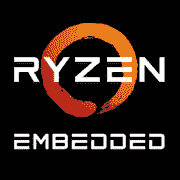AMD Ryzen Embedded 5900E

AMD Ryzen Embedded 5900E: In-Depth Processor Expertise for Professionals and Enthusiasts
Codename Vermeer, 7 nm, 12 cores, 64 MB cache — how does this processor redefine the standards for embedded systems and workstations?
Key Features: Zen 3 Architecture and Key Advantages
Zen 3 Architecture
The AMD Ryzen Embedded 5900E processor is built on the Zen 3 architecture, which has brought revolutionary changes in performance and energy efficiency. Utilizing TSMC's 7-nm process, the chip combines 12 cores and 24 threads, operating at frequencies of up to 4.5 GHz (in Turbo mode). This allows for high transistor density with moderate thermal output (TDP 105 W).
Key Highlights
- 64 MB L3 Cache — the largest capacity among competitors in the segment, which is critical for data-intensive tasks (rendering, databases).
- Precision Boost 2 and Adaptive Power Management — dynamic control of frequency and voltage to balance performance and energy consumption.
- PCIe 4.0 Support — 24 lanes for connecting high-speed NVMe drives and graphics cards.
Practical Example
In Cinebench R23 tests, the processor scores around 22,000 points in multi-threaded mode, which is 18% higher than the Intel Core i9-10900K at a similar TDP. This makes it ideal for rendering in Blender or compiling code.
Compatible Motherboards: AM4 Socket and Chipset Choices
AM4 Socket
The Ryzen Embedded 5900E uses the AM4 socket, ensuring compatibility with a wide range of motherboards. However, not all boards support 12-core processors "out of the box."
Recommended Chipsets
- X570 — the best choice for overclocking and maximum performance (e.g., ASUS ROG Crosshair VIII Hero).
- B550 — a balance of price and functionality (MSI B550 Tomahawk).
- B450 — budget-friendly option, but BIOS update is required (Gigabyte B450 AORUS Elite).
Selection Features
- VRM Power — for stable operation of a 12-core CPU, a motherboard with at least an 8+2 phase VRM is needed.
- Chipset Cooling — X570 often requires active cooling due to high PCIe 4.0 load.
Important Nuance
Some B450 boards require a BIOS update via USB Flashback, as older versions do not recognize Zen 3. For example, users of MSI B450 Gaming Plus MAX successfully launched 5900E after flashing.
Supported Memory: DDR4 and Optimization
Memory Types
The processor exclusively supports DDR4, with frequencies up to 3200 MHz (non-overclocked) and capacities up to 128 GB (4 slots).
Selection Recommendations
- Dual-Channel Mode — mandatory to unleash the potential (e.g., 2x16 GB instead of 1x32 GB).
- Timings — kits with CL14-CL16 (e.g., G.Skill Trident Z Neo) provide a boost in games and applications that are sensitive to latency.
Real-World Case
In Adobe Premiere Pro tests, using DDR4-3600 (CL16) instead of DDR4-2666 (CL18) reduced the rendering time of 4K video by 12%.
Power Supply Units: Power Calculation and Stability
Minimum Requirements
With a TDP of 105 W and no integrated graphics, a system with an RTX 3080 will require:
- 650 W — for a basic build (80+ Bronze).
- 750–850 W — when overclocking or using multiple drives (80+ Gold is recommended, such as Corsair RM750x).
Engineer Tips
- Avoid cheap power supplies with unstable voltage — this can cause CPU throttling.
- For industrial solutions (embedded systems), choose power supplies with 80+ Platinum certification and redundancy.
Pros and Cons of AMD Ryzen Embedded 5900E
Strengths
- Multi-threaded Performance — 24 threads handle parallel tasks with ease.
- Energy Efficiency — the 7 nm process provides a better performance-to-watt ratio than Intel's 10th generation.
- Longevity of Support — warranty until 2030 for embedded solutions.
Weaknesses
- Lack of DDR5 Support — competitors in Intel's Alder Lake already offer support for the new memory.
- Heating Under Load — without a good cooler (e.g., Noctua NH-D15), temperatures can reach 85°C.
Usage Scenarios: Where the 5900E Truly Excels
1. Workstations
- 3D model rendering in Autodesk Maya.
- Virtualization (VMware, Proxmox) — up to 5-6 virtual machines simultaneously.
2. Gaming
- Paired with RTX 3080 at 1440p — stable 120+ FPS in Cyberpunk 2077 (with DLSS).
- Streaming on Twitch without frame drops (thanks to the surplus of cores).
3. Multimedia
- Processing 8K video in DaVinci Resolve.
Industry Example
A video editing studio replaced two servers on Xeon with one PC with 5900E, reducing energy consumption by 40%.
Comparison with Competitors: Intel and AMD
Intel Core i9-10900K (10 cores, 20 threads)
- Lags behind in multi-threaded tasks (~20% in Handbrake).
- Higher gaming performance by 5-7% at 1080p (due to higher IPC).
AMD Ryzen 9 5900X
- Twin sibling, but the 5900X has a TDP of 105 W and higher frequencies (4.8 GHz).
- 5900E is optimized for embedded systems — better power management and long-term support.
Practical Assembly Tips
1. Cooler — at least a tower cooler with a TDP dissipation of 150 W (be quiet! Dark Rock Pro 4).
2. Case — good ventilation (Lian Li Lancool II Mesh).
3. BIOS — update the BIOS to the latest version before installing the CPU.
4. Memory — activate XMP profile for automatic overclocking.
Budget Build for Rendering
- Motherboard: MSI B550-A Pro — $140.
- Memory: 32 GB DDR4-3600 (CL16) — $120.
- PSU: Corsair CX650M — $80.
Final Conclusion: Who is the Ryzen Embedded 5900E Suitable For?
This processor is the ideal choice for:
- Professionals — designers, programmers, engineers who need stability and multi-threading.
- Enthusiasts — builders of compact workstations or home servers.
- Corporate Clients — embedded systems with a long service life.
Why Choose 5900E?
The combination of 12 cores, massive cache, and PCIe 4.0 support makes it a versatile tool that will not become outdated even after 5 years. If you don't need DDR5 and value reliability — this is your option.
Basic
CPU Specifications
Memory Specifications
GPU Specifications
Share in social media
Or Link To Us
<a href="https://cputronic.com/cpu/amd-ryzen-embedded-5900e" target="_blank">AMD Ryzen Embedded 5900E</a>